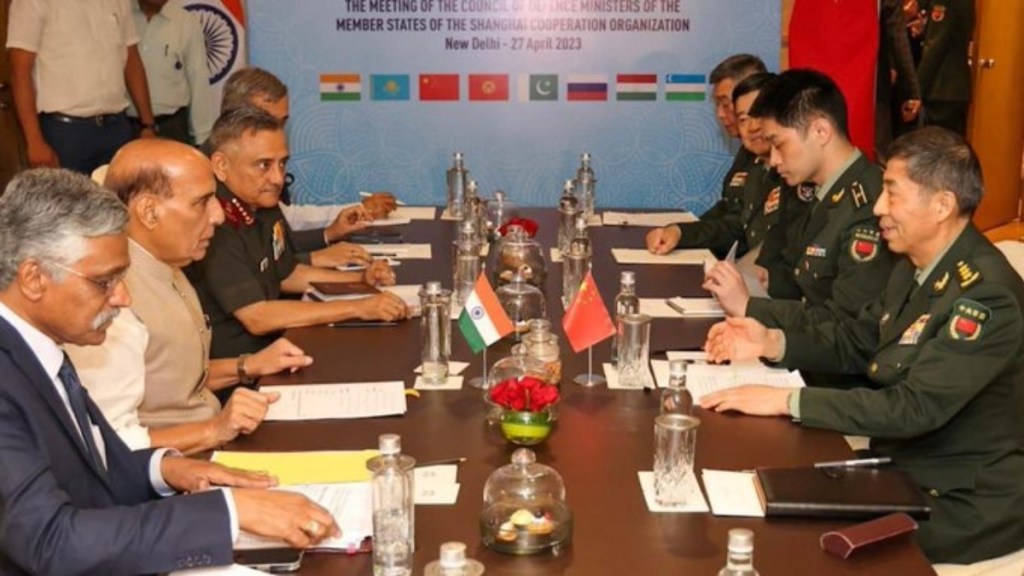By Farooq Wani
Last week has been an interesting one, insofar as Sino-Indian relations are concerned for two reasons. One, despite the on-going border tensions between the elephant and the dragon, Chinese Defence Minister Gen Li Shangfu flew down to attend the SCO Defence Ministers’ meeting, and two, he had a bilateral dialogue with his Indian counterpart Rajnath Singh.
While nothing spectacular emerged from Gen Shangfu’s visit and the interaction between the two defence ministers, the one thing that’s become amply clear is that New Delhi isn’t being cowed down by Chinese belligerence. So, while both countries spoke in one voice on the need to eliminate the threat of terrorism and fix accountability on those who aid or fund terror, they remain divided on the Sino-Indian border issue.
Though Beijing has been talking about peace and normalcy with India, its duplicity isn’t hidden from the international community and this was palpable during Gen Shangfu’s visit. Symbolism is an important ingredient of diplomacy and the Chinese defence minister could have at least given Beijing’s peace charade a semblance of respectability by the customary wreath laying at the National War Memorial. However, Gen Shangfu didn’t bother to do so.
Also Read: Large presence of Chinese vessels in Indian Ocean region, India keeping close watch: Navy chief
There is no doubt that the Sino-Indian border issue is a serious one. India and China fought a war in 1962, followed by the 1967 bloody border clashes in the Nathu La area of Sikkim. In 1986-87, there was a stand-off between the Indian army and Peoples’ Liberation Army (PLA) of China in the Sumdorong Chu Valley bordering the Tawang district in Arunachal Pradesh. This was followed by similar incidents at Doklam in 2017 and more recently, at Galwan in 2020.
The stiffness in response and body language, according to analysts, was all pervading on both sides during General Li’s five-day trip. It is clear as daylight that both sides are weighed down by growing border tensions, increased defence expenditures and differing opinions on a host of other issues, including maritime matters relating to the Indo-Pacific Region (IOR), the China Pakistan Economic Corridor (CPEC) and Belt and Road Initiative (BRI).
China is feeling a degree of unease due to India’s rapid economic progress and is also suspicious of what it perceives as New Delhi’s growing proximity to the United States. However, while it’s apparent that New Delhi is in no mood to become part of US led anti-China lobby, it has become more wary of China’s physical attempts to forcibly fulfil its territorial ambitions and as such has justifiably enhanced its defensive capability along the Line of Control (LAC).
Gen Shangfu’s seemingly reconciliatory view that Beijing sees the border as being stable and so “both sides should look to the long term put the border issue in the proper place within bilateral relations and promote an early transition of the border situation towards normalised control”, failed to cut any ice. Singh had a terse and simple message for his Chinese counterpart that better bilateral ties have to be premised on the “prevalence of peace and tranquillity at the borders.”
Also Read: Rajnath Singh meets Chinese Defence Minister, discuss border concerns
That frosty ties between the two sides persisted became evident when both ministers skipped the formality of shaking hands during a bilateral meeting and at the SCO interaction, but shook hands with their counterparts from other nations. All that India and China have achieved after 18 rounds of military talks since the 2020 Galwan Valley clashes is just an agreement to speed up progress towards resolving the border dispute and exchange views “in an open and candid manner”.
Today, the Sino-Indian agreements of 1993 and 1996 to maintain peace along the LAC lie in tatters, thanks to Beijing’s border unprovoked transgressions in Eastern Ladakh. So, while Beijing may try and tell the world that’s all well on the LAC, New Delhi has made it clear that things here are far from normal, and Beijing doesn’t like India’s plain speak as it exposes China as the sole architect of this problem that could have regional and even global ramifications.
At the multilateral level, the focus predictably was on the issue of terrorism, with Rajnath Singh being emphatic about New Delhi’s objections to any nation sheltering terrorists and encouraging proxy wars in the neighbourhood to keep the region destabilised and imbalanced. This, he said, has the potential to radicalise the next generation and stymie socio-economic progress of a society, or societies.
“If we want to make SCO a stronger and more credible international organisation, our top-most priority should be to effectively deal with terrorism,” he said.
In an indirect reference to China, Singh said that violation of existing agreements has eroded the entire basis of bilateral relations and disengagement at the border, and strongly advocated status quo ante on troop deployment as it’s a logical way to facilitate de-escalation tension along the LAC.
Though no breakthrough on the border issue may have been reached, both India and China have agreed to keep all channels of communication open to work towards mutually acceptable resolution of all disputes. Since both sides have dug in their heels, an early outcome is unlikely, but there’s no reason to give up hope.
Avoiding conflict and confrontation on the border at all costs is paramount, especially at a time when all eyes are on an economically struggling Europe because of the Russo-Ukraine War, and luckily both China and India have taken the wise decision of ensuring that their troops don’t come in physical contact as the same could make things go out of control.
The author is Editor Brighter Kashmir, author, TV commentator, political analyst and columnist.
Disclaimer: Views expressed are personal and do not reflect the official position or policy of Financial Express Online. Reproducing this content without permission is prohibited.


